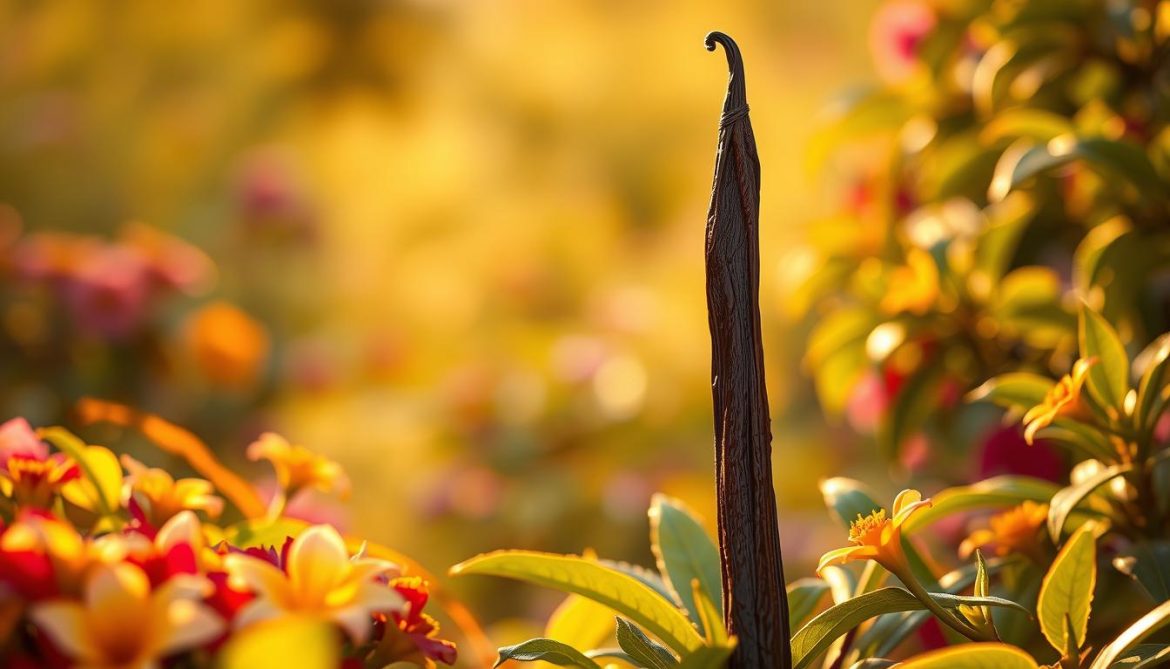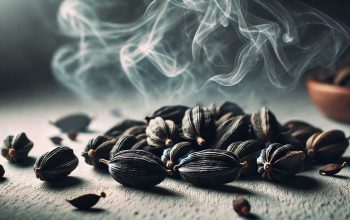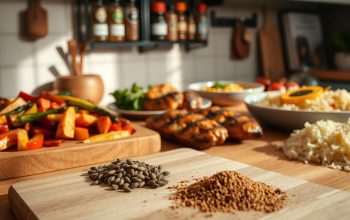Welcome to the magical world of vanilla, the queen of spices! I’m excited to share my passion for this incredible ingredient. It has captured hearts and taste buds across generations. We’re about to explore its rich history and culinary magic.
Vanilla isn’t just a simple flavoring. It’s a global treasure with an incredible story. Ancient civilizations revered it, traders fought for it, and chefs worship it. We’ll uncover why vanilla truly deserves its royal title.
In this guide, I’ll share fascinating stories and uses of vanilla. It’s a culinary superstar. Whether you’re a home cook or a food lover, get ready to be amazed by vanilla’s journey.
Are you ready to dive into the world of vanilla? Let’s begin our flavorful adventure together!
The Ancient Origins of Vanilla: From Mesoamerica to Global Fame
Vanilla’s journey started in Mesoamerica’s green landscapes. It’s a tale of history and origins that’s as captivating as a story. The story of vanilla beans is tied to the rich cultures of ancient civilizations.
The Totonac Legend and Vanilla’s Discovery
The Totonac people of Mexico were the first to grow and value vanilla beans. They have a legend about how they found vanilla. It’s a story of love between a princess and a warrior, showing the deep bond between humans and nature.
“In the heart of the Mexican forests, vanilla was more than a spice – it was a sacred gift from the gods.” – Traditional Totonac Saying
- Native to Veracruz, Mexico
- First cultivated by Totonac indigenous people
- Considered a valuable trading commodity
Spanish Conquistadors and Vanilla’s Journey to Europe
When Hernán Cortés, a Spanish conquistador, met the Aztecs, he found vanilla’s amazing taste. This spice quickly became a hit in Europe, moving from a local treasure to a worldwide favorite.
| Period | Vanilla Transformation |
|---|---|
| Pre-1520 | Indigenous Mexican use |
| 1520-1600 | Introduction to European courts |
| 1600-1700 | Expanding global trade routes |
Vanilla’s journey from Mesoamerica to kitchens around the world is amazing. It shows how unique and important vanilla is. Each bean tells a story of adventure, love, and new flavors.
Understanding the Vanilla Orchid: Nature’s Precious Gift
Welcome to the magical world of vanilla orchids – nature’s most extraordinary and delicate treasure! These remarkable plants are far more than just a pretty face in the botanical kingdom. Vanilla orchid cultivation requires incredible patience, skill, and dedication that few other crops can match.
Let’s dive into the fascinating characteristics of these incredible plants. The vanilla orchid, scientifically known as Vanilla planifolia, is a climbing vine that grows naturally in tropical forests. Unlike other orchids you might know, this species produces the precious vanilla beans that transform desserts and cuisines worldwide.
“The vanilla orchid is not just a plant, it’s a miracle of nature waiting to be understood.” – Botanical Experts
- Native to Mexico and Central America
- Requires specific growing conditions
- Manually pollinated by skilled farmers
- Takes 3-5 years to produce first vanilla beans
Growing vanilla beans is an art form that demands extraordinary care. Each vanilla orchid plant must be nurtured with precise environmental conditions – warm temperatures, high humidity, and filtered sunlight. Farmers must hand-pollinate each delicate flower, making vanilla orchid cultivation a labor-intensive process.
The complexity of vanilla orchid cultivation explains why pure vanilla is so expensive. Each vanilla bean represents months of careful cultivation, precise environmental management, and human expertise. It’s truly a testament to the incredible relationship between humans and nature!
Vanilla: The Queen of Spices – Why It Earned This Title
Get ready to explore the world of vanilla, a spice loved by many. It’s not just a flavor; it’s a true culinary queen. Its story spans continents and centuries.
Cultural Significance Across Continents
Vanilla has been a part of human culture for ages. It started with ancient Mesoamericans and now reaches kitchens everywhere. Its journey shows its incredible appeal and flexibility.
- Revered by Aztecs as a sacred ingredient
- Treasured in European royal courts
- Celebrated in global culinary traditions
Economic Impact on Global Markets
The vanilla industry is huge in global trade. Madagascar, mainly the Sava region, makes over 80% of the world’s vanilla. This boosts the local economy a lot.
“Vanilla is more than a flavor – it’s a global economic phenomenon.”
Culinary Prestige and Versatility
So, why is vanilla the queen of spices? It can make any dish special. It adds a unique flavor to both sweet and savory dishes.
- Baking and pastry arts
- Gourmet cooking
- Beverage production
- Perfume and cosmetic industries
Vanilla’s fame isn’t just about taste. It’s about experience. Each vanilla bean has a story of tradition and magic. It continues to delight food lovers everywhere.
The Art of Vanilla Bean Cultivation
Vanilla orchid cultivation is a delicate and intricate process. It turns a beautiful flower into the world’s most beloved spice. Growing these magical plants requires patience, skill, and a deep understanding of their unique ecosystem.
Let’s explore the fascinating world of artisanal vanilla production! These incredible orchids demand specialized care and attention from the moment they’re planted.
Key Requirements for Vanilla Orchid Growth
- Tropical climate with consistent temperatures
- High humidity levels (80-90%)
- Partial shade conditions
- Well-draining, rich organic soil
- Support structures for climbing vines
Vanilla orchids are epiphytic plants that naturally grow on other trees in tropical rainforests. This unique characteristic makes their cultivation both challenging and rewarding for dedicated farmers.
“Vanilla cultivation is an art form that requires more dedication than most agricultural practices.” – Vanilla Growing Expert
The cultivation process involves careful propagation techniques. Farmers typically use vegetative reproduction, taking cuttings from mature vanilla vines and nurturing them in controlled environments.
| Cultivation Stage | Duration | Key Requirements |
|---|---|---|
| Propagation | 3-4 months | Controlled humidity, indirect light |
| Initial Growth | 1-2 years | Support structures, consistent care |
| Flowering | 3-4 years | Hand pollination, precise environmental conditions |
Artisanal vanilla production is not just agriculture—it’s a passion. It transforms delicate orchids into the world’s most exquisite spice. Each vanilla bean tells a story of meticulous care, traditional knowledge, and botanical magic!
Traditional Vanilla Curing Process: From Green to Brown
The vanilla curing process turns green vanilla pods into the rich, brown beans we love. Making artisanal vanilla needs skill, patience, and a deep understanding of old techniques.
Harvesting and Killing Stage
When vanilla pods are ripe, farmers carefully pick them. The killing stage is key. It stops the pod’s growth and starts flavor development.
- Pods are picked when they start to yellow at the tip
- Immediate treatment stops the pod from growing
- Killing methods include hot water or sun exposure
Sweating and Slow-Drying Methods
Artisanal vanilla production uses precise sweating and drying. These methods concentrate flavors and create complex aromas.
| Stage | Duration | Process |
|---|---|---|
| Sweating | 24-48 hours | Wrapped in wool blankets to induce fermentation |
| Initial Drying | 1-2 weeks | Alternating sun exposure and shade |
Conditioning and Grading
The final stage involves carefully conditioning the beans. Experts grade vanilla based on length, moisture, and appearance.
“Great vanilla is not made, it’s carefully crafted with love and tradition.” – Vanilla Master
- Beans are sorted by quality
- Conditioning continues for several months
- Premium beans develop deep, complex flavors
Different Types of Vanilla Beans Worldwide
Explore the world of vanilla beans, where each type has its own story. Vanilla isn’t just one bean; it’s a global treasure with amazing diversity. It will make your taste buds dance.
Let’s look at the most celebrated vanilla beans from around the world:
- Madagascar Bourbon Vanilla Beans: These beans are the stars of vanilla flavoring. They come from the Bourbon Islands and have a rich, creamy taste.
- Tahitian Vanilla Beans: These beans are a bit different from Madagascar ones. They have a more floral and fruity flavor.
- Mexican Vanilla Beans: These are the original vanilla beans. They have a smooth and deep flavor that started it all.
Each vanilla bean has its own unique taste. Madagascar beans are often seen as the best, with a strong flavor. Tahitian beans have a lighter taste, great for delicate desserts.
“Vanilla is not just a flavor – it’s a journey through different cultures and landscapes!” – Vanilla Enthusiast
When picking vanilla beans, think about where they come from and how you’ll use them. Mexican beans have a traditional taste, while Tahitian ones are perfect for complex dishes. The world of vanilla beans is vast and exciting!
| Vanilla Bean Type | Flavor Profile | Best Used In |
|---|---|---|
| Madagascar Bourbon | Rich, Creamy | Baking, Ice Cream |
| Tahitian | Floral, Fruity | Delicate Desserts |
| Mexican | Smooth, Traditional | Traditional Recipes |
Ready to become a vanilla bean connoisseur? Each variety offers a unique glimpse into the world of vanilla flavoring. It’s waiting to transform your culinary adventures!
Making Pure Vanilla Extract: A Detailed Guide
Creating your own vanilla extract is a fun journey into making your own vanilla. It turns simple ingredients into a treasure for your kitchen. You’re about to start a tasty adventure that will make your cooking better!
Making vanilla extract at home is simpler than you think. I’ll show you how to make vanilla beans into a flavorful liquid. It’s a process that will make your food taste amazing!
Ingredients and Equipment Needed
- High-quality vanilla beans
- High-proof vodka or rum
- Glass jar with tight-fitting lid
- Sharp knife
- Cutting board
Step-by-Step Extraction Process
- Select premium vanilla beans – look for plump, dark, and fragrant varieties
- Split vanilla beans lengthwise, exposing the tiny seeds inside
- Place split beans in clean glass jar
- Pour high-proof alcohol over beans, completely submerging them
- Seal jar tightly and store in cool, dark place
Your homemade vanilla extract needs patience. The magic happens over a slow infusion process that takes 2-3 months. Shake the jar once a week to mix the flavors.
“Patience is the secret ingredient in creating the most incredible vanilla extract!” – Vanilla Enthusiast
| Extraction Stage | Duration | Expected Result |
|---|---|---|
| Initial Infusion | 2-3 months | Light amber color, mild flavor |
| Peak Flavor | 6-12 months | Deep amber, rich vanilla essence |
Pro tip: Use Madagascar or Tahitian vanilla beans for the best vanilla extract. Your homemade version will be better than any store-bought one!
Natural vs. Artificial Vanilla Flavoring
Let’s dive into the world of vanilla flavoring. We’ll look at the differences between natural and artificial types. Knowing about vanilla beans can change how you cook!
Natural vanilla flavor comes from vanilla beans. These beans grow on orchid plants from Mexico. They go through a special curing process that makes their flavor rich and complex. On the other hand, artificial vanilla is made to taste like the real thing but is not.
- Natural vanilla has over 250 flavor compounds
- Artificial vanilla mainly uses vanillin
- Price affects what people choose
Chefs and bakers often talk about vanilla flavoring. Natural vanilla beans give a deeper, more complex taste. But, artificial vanilla is cheaper and works well in many recipes.
| Characteristic | Natural Vanilla | Artificial Vanilla |
|---|---|---|
| Origin | Vanilla Orchid Beans | Synthetic Laboratory Production |
| Flavor Complexity | Rich, Multilayered | Simple, One-Dimensional |
| Cost | Expensive | Affordable |
“True flavor comes from authenticity” – Culinary Masters
Think about what your recipe needs and your budget when picking vanilla flavoring. Vanilla beans add a unique depth. But, artificial vanilla is good for many baking tasks.
Health Benefits and Nutritional Value of Vanilla
Vanilla is more than just a tasty spice. It’s packed with health benefits that might amaze you! This magical ingredient adds incredible flavor to your favorite dishes.
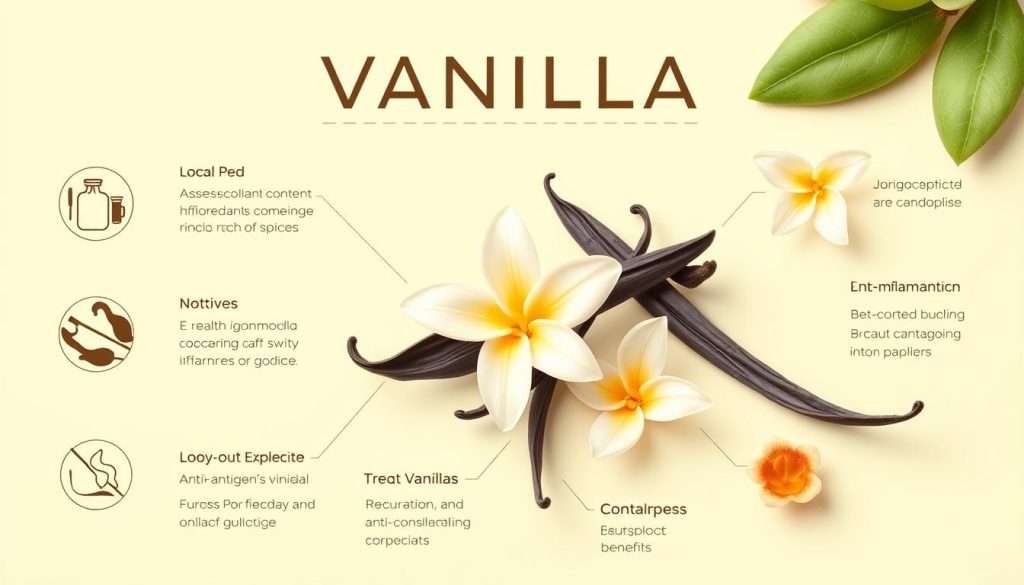
Exploring vanilla’s health benefits opens a world of wellness. Vanilla is not just a sweet treat. It’s a natural treasure full of healing properties.
Antioxidant Powerhouse
Vanilla is full of antioxidants that protect your body from harm. These tiny defenders:
- Reduce cellular damage
- Support overall immune function
- Potentially lower inflammation
“Nature’s most delicious medicine comes in the form of vanilla” – Wellness Experts
Therapeutic Applications
Vanilla is not just tasty. It has amazing therapeutic potential. Research shows vanilla might:
- Mental health through stress reduction
- Potential mood enhancement
- Natural anxiety management
Vanilla promotes relaxation and might support heart health. It truly deserves its royal title as the queen of spices!
Culinary Applications: Beyond Baking
Vanilla flavoring is more than just for sweet treats! I’m excited to show you how it can change savory dishes. Gourmet vanilla recipes are surprising home cooks everywhere.
- Enhance savory sauces with a drop of vanilla extract
- Create complex marinades for meats and seafood
- Add depth to vegetable roasting blends
- Experiment with vanilla-infused salad dressings
Imagine making a simple roast chicken special by rubbing it with vanilla bean paste and herbs. The subtle sweetness balances the richness, creating a flavor that will amaze your dinner guests!
“Vanilla is not just a flavor, it’s a culinary adventure waiting to happen!” – Professional Chef
Savory cooking with vanilla opens up new possibilities. Professional chefs have long known that vanilla flavoring can add complexity to dishes beyond desserts. From French cuisine to modern molecular gastronomy, vanilla proves itself as a versatile ingredient that goes beyond traditional uses.
- Seafood glazes with vanilla undertones
- Vanilla-infused olive oils
- Gourmet vanilla recipes for protein marinades
Ready to become a vanilla culinary wizard? Start experimenting and watch your dishes come alive with unexpected depth and sophistication!
Storing and Preserving Vanilla Products
Keeping your vanilla beans and extract fresh is an art. It ensures they stay flavorful and of high quality. Whether you love baking at home or enjoy cooking, the right storage makes a big difference.
Storing vanilla products right is key. It affects how long they last and how strong their flavor is.
Optimal Storage Conditions for Vanilla Beans
Here are important tips for storing vanilla beans:
- Keep them in a cool, dark spot away from sunlight
- Keep the temperature between 60-70°F
- Use airtight glass containers with tight lids
- Avoid the fridge to prevent moisture
Shelf Life Guidelines for Vanilla Extract
Vanilla extract lasts a long time if stored right. Here’s what you need to know:
- Pure vanilla extract can last 5-10 years if sealed well
- Keep it away from heat and light
- Store in a dark glass bottle or opaque container
“A well-preserved vanilla bean or extract is like a hidden treasure in your pantry!” – Culinary Experts
Pro tip: Check your vanilla beans often. White spots are okay! They’re vanillin crystals, showing the vanilla is of high quality.
By following these tips, your vanilla beans and extract will stay flavorful for months or years!
Sustainable Vanilla Farming Practices
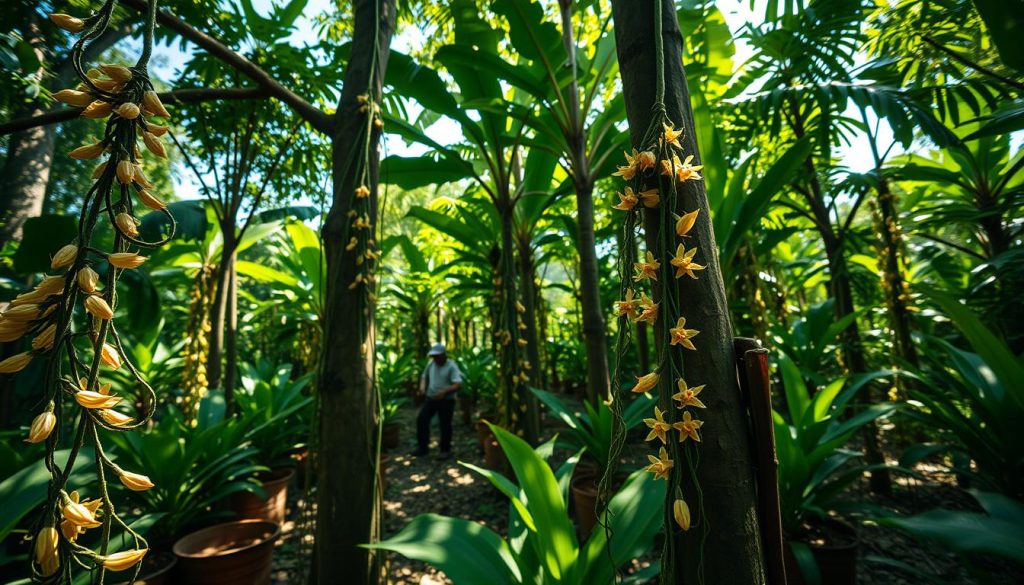
Vanilla orchid cultivation is more than growing a tasty crop. It’s about caring for our planet and helping local communities. As someone who loves food, I’ve found the amazing world of sustainable vanilla production.
Let’s look at the main practices that make vanilla production green and fair:
- Agroforestry techniques that keep natural ecosystems safe
- Organic farming that avoids harmful chemicals
- Fair trade that helps local farmers
- Water and soil conservation
The best sustainable vanilla farming mixes old wisdom with new eco-friendly methods. Small-scale farmers become environmental guardians, protecting nature and growing top-notch vanilla beans.
“Sustainable farming is not just about production, it’s about creating a harmonious relationship between people and nature.” – Sustainable Agriculture Expert
Important sustainability metrics for vanilla orchid cultivation include:
| Practice | Environmental Impact | Community Benefit |
|---|---|---|
| Shade-grown cultivation | Protects forest ecosystems | Preserves local biodiversity |
| Organic fertilization | Reduces chemical runoff | Improves soil health |
| Fair trade certification | Supports sustainable practices | Ensures fair wages |
By picking sustainably made vanilla, you’re not just getting a great taste. You’re backing a worldwide movement of responsible farming. Every bean has a story of caring for the environment and uplifting communities!
The Future of Vanilla Production and Innovation
I’m excited to dive into the new world of vanilla production. New technologies and green practices are changing how we grow and enjoy vanilla. Genetic studies and advanced farming methods are creating new possibilities for this special spice.
Vertical farming and precision agriculture are big steps forward for vanilla farming. Scientists are working on vanilla plants that can fight off diseases and grow in different places. Greenhouses let farmers grow vanilla all year, opening up new areas for farming.
Blockchain is making vanilla buying fairer and more transparent. It helps small farmers sell directly to buyers worldwide. This means they get paid better and farm in a more ethical way. New ways to extract vanilla are making essences stronger and more eco-friendly.
The future of vanilla is very promising. With genetic engineering and digital market changes, vanilla is getting a big makeover. Get ready for a flavor explosion that blends old traditions with new tech!
